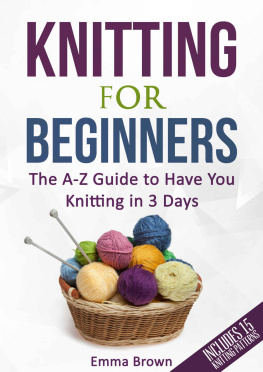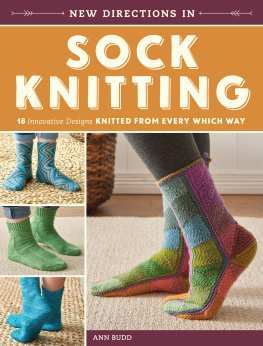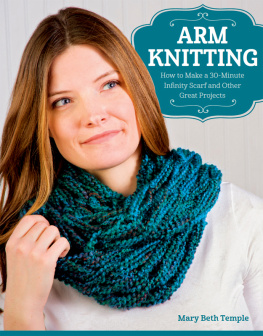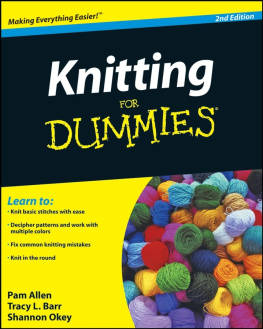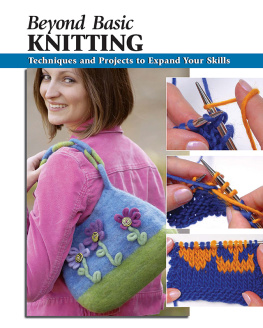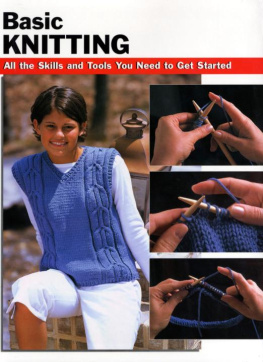

CONTENTS
Introduction
Welcome to the world of knitting! Knitting is so much more than just a way to make something. Youll soon discover that the process of knitting is relaxing and even therapeutic. The rhythmic and repetitive motion is very calming and restful. Many knitters look forward to their quiet time with needles and yarn as the best part of their day. Knitters also love to share their craft, and knitting groups, social networking sites, knitting conventions, and, yes, knitting books are abounding.

It doesnt require a big investment to learn how to knit. Youll need a good instructional book (like this one!), yarn, and needles. Your time investment isnt huge either. It only takes a few hours to learn the basic skills needed to make a simple scarf. Once you become hooked by knitting youll find that youre eager to add new skills and make items with more complexity.
How to Use This Book
This book teaches you a wide range of knitting skills from the most simple, basic ones to more advanced techniques that will launch you confidently into the full spectrum of knitting options. There are seven chapters, and each one begins by teaching the skills needed to make the projects in that chapter. Each project provides a list of What Youll Learn and also What Youll Need.

PRACTICE SWATCHES
Especially in the beginning chapters, you will be encouraged to make practice swatches so you can learn a skill before you use it on expensive yarn in the finished project. Buy a skein of high-quality, worsted weight, wool yarn that knits at a gauge of 20 stitches = 4" (10 cm) (or 5 stitches to 1" [2.5 cm]). (See for details about needles.)
If youre a new knitter, then the best approach is to start with the first chapter and work your way through the book. You dont have to make every project, but spend time learning the skills and in particular making the practice swatches. The first three chaptersBasic Knitting, Texture, and Shapingwill give you a solid skill set that will prepare you for the remaining chapters, which can be read in any order. Throughout the book, each new chapter builds on the skills that were presented earlier. So, if you read the chapters out of order, be sure to use the index to locate and learn any information you might have missed in a prior chapter.
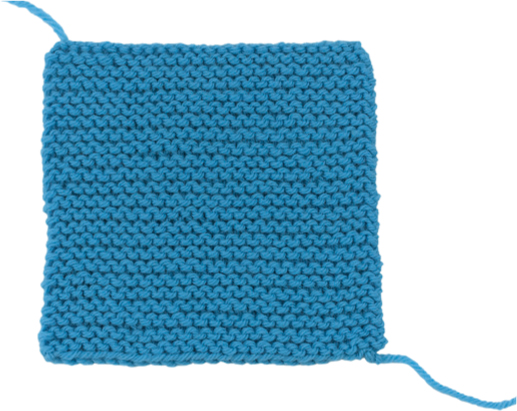
Yarn and Tools
Of all the handcrafts, knitting is the easiest one to bring along with you. Thats because the tools and materials are so simple; to get started you really only need yarn and knitting needles.
YARN
Yarn is simply a continuous strand of twisted fiber. The fiber can be anything from naturals like wool or cotton to luxury fibers such as cashmere and silk. Youll also find more unusual fibers such as bamboo, Tencel, and linen and, of course, less expensive synthetic fibers such as nylon and acrylic. In addition, an abundance of yarns exist that are combinations of all the fibers available such as cotton/bamboo, wool/silk, or linen/acrylic. The selection can be mind boggling, so it may be helpful to find a good, independent yarn shop in your area. The local yarn shop (affectionately nicknamed LYS) is the perfect place to learn about yarn and find reinforcement for the skills that are taught in this book. Yarn shops are typically staffed by expert knitters who are eager to guide your success when you venture beyond what youve learned in this book. Good craft or hobby stores and comprehensive online shops also carry a wide assortment of yarns, needles, and instructional materials.
Texture
Yarn for handknitting comes in a variety of textures and different weights. In terms of texture, youll find a wide range from smooth to wildly eclectic and bumpy. The photo below shows a range from left to right of smooth (merino wool), bumpy (cotton), boucle (alpaca/nylon), thick and thin (wool), fuzzy (mohair), chenille (rayon), eyelash (nylon), slub (nylon/metallic), and ribbon (nylon). The projects in this book use yarns that are primarily smooth or just a little bumpy because those are the ones that are most manageable for a new knitter.
Weight
Yarn is classified by the thickness or diameter of the strand and this classification is commonly you will find an in-depth discussion of yarn weight and how to combine yarns for more variety in your knitting.

Yarn Packaging
Yarn packaging (sometimes referred to as put-up) comes in a variety of forms. There are balls (they look like a doughnut) and skeins, which are densely wound and wrapped around the middle with a ball band (label). Both balls and skeins are ready to be used; simply pull the end out of the center. Another common put-up is a hank which looks like a loosely twisted braid. Its very important to wind the yarn from the hank into a ball before you begin knitting, otherwise it will become tangled. Your LYS will often wind the yarn for you or let you use their equipment. If not, untwist or unfold the hank; youll find it in a loose circle. Put both hands inside the circle and give a few good snaps outward, then drape it over the back of a chair or ask a friend to hold it. The yarn may be tied in two or three places to keep the hank from tangling. Find the ends and cut or untie the knots. Working with one end, wind the yarn into a ball (like your grandma made or your kitty would play with).

Yarn Label
Learn to read and interpret the information on a yarn label (also known as a ball band). Youll find some basic and predictable information such as the manufacturer, the country of origin, and fiber content. Youll also see the color number and/or name as well as the dye lot, which refers to the batch the yarn was dyed in. Its important to buy enough yarn to make your project, plus a margin for error, from the same dye lot. If you run out and have to purchase yarn from a different dye lot, then the color may not match, leaving a distinct line where the new dye lot starts.
Most yarn labels also include a distinctive square that gives information about the recommended gauge (number of stitches and rows per inch) and recommended needle size (). Sometimes the square is omitted but you will always find needle and gauge information. The number of stitches per inch is an important number because it defines the weight of the yarn and lets you know whether the yarn is appropriate for the pattern you are using.
Next page

